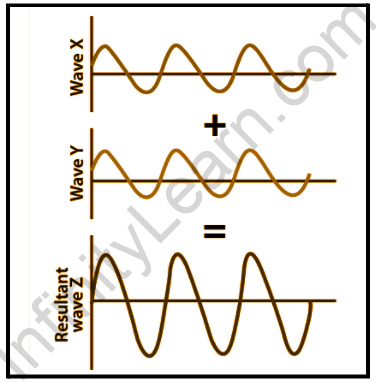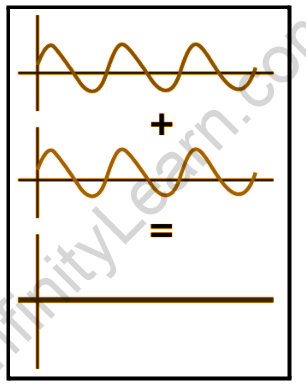Table of Contents
Introduction
We can say that interference is a natural event that arises everywhere and at any time. Interference patterns, on the other hand, aren’t always visible. Interference occurs when two waves unite to produce a new wave of lesser, bigger, or equal amplitude. It is known that optical interference, often called light interference, is the most prevalent kind of interference. Most of the sources create light waves in a random manner. This implies that the amplitude, frequency, and phase of light waves emitted by a source are not constant. The soap bubble, which reflects a wide range of colours when illuminated by a light source, is the most common example of light interference. Incandescent bulbs, for example, provide a wide variety of light frequencies, along with all of the rainbow’s colours. Furthermore, the light emanating from the bulb is formed at random in all directions at all times. This implies that the wave’s reference point could be a maximum, a minimum, or anything in between. There is no way to know which phase the wave will begin in. A source like this is said to be incoherent.
The information about interference from various physics-related articles are available here. Interference and its general concepts are important topics in physics. Students who want to flourish in physics need to be well known about interference of light and interference of waves to get deep knowledge about it to do well on their exams. The definition, brief explanation, and types are provided here to assist students in effectively understanding the respective topic. Continue to visit our website for additional physics help.
Overview
Interference is the result of two or more waves colliding and superposing to create a new wave with a different amplitude depending on the nature of the superimposition or alignment of the overlapping waves’ peaks and troughs. When two or more waves arrive at the same place while moving through the same medium, they superimpose on each other, or, to put it another way, the waves’ disturbances superimpose when they collide. Each of these disruptions represents a force, and we all know that forces pile up.
There will be a change in the energy of the light distribution when two or more waves superimpose on each other. Interference is the term for this condition. The waves radiated from the source should have zero phase difference or no phase difference for interference. It’s crucial to keep in mind that the source should generate waves of the same wavelength for the same amount of time. Furthermore, both sources should be in close proximity to one another. The observed interference pattern is stable if the waves are coherent.
The observed interference pattern is not stable and unnoticeable if the waves are incoherent.
Coherent Sources of Light and Sustained Interference
Light interference is a natural occurrence. Light interference can occur in any location and at any time. When two light waves of different amplitudes are superimposed, the resultant wave is referred to as interference. Optical interference, often known as light interference, is a type of interference. As the light leaves can create at random from a variety of sources. As a result, the amplitude, phase, and frequency of light waves emitted by a source are not constant.
The Principle of Linear Superposition
The principle of linear superposition, which applies to any number of waves, states that when two or more waves of the same type collide at the same point, the resultant amplitude at that point equals the vector sum of the individual waves’ amplitudes. To simplify things, consider what happens when two waves collide.
For example, sound from two different sources reaching you at the same time, or two pulses flowing along a string towards each other. When these waves collide, the outcome is superimposed waves that add up, with the amplitude at each location equal to the sum of the separate waves’ amplitudes at that point. Despite the fact that these waves collide when they meet, they continue on their way as if they had never met before.
Wave Interference
We can watch light and sound undergo a variety of changes in our daily lives. As per this, the sky’s blue colour is because of the presence of light. When an object transitions from air to water, light plays an important role in its appearance. Light creates an amazing illustration in the form of a rainbow. The echo is the consequence of sound being reflected. As we know SONAR is a sound propagation method for communicating, navigating, and detecting objects on or beneath the water’s surface. These phenomena can be detected because light and sound waves can suffer reflection, refraction, polarisation, and interference. Along with these effects, light can also be subjected to diffraction, interference, refraction, and scattering.
Wave interference occurs when two waves travel through the same medium at the same time. When two waves collide or superimpose while moving, this phenomenon occurs. When two waves collide, the resultant wave is generated. The sum of the constituent waves determines the value of the resultant wave.
There are two forms of interference:
(1) Constructive Interference
(2) Destructive Interference
Constructive Interference
When two waves travel in the same direction and are in phase with each other, their amplitudes are put together to produce the resultant wave. The waves are claimed to have been constructively interfered with here. The upward displacement of the medium is higher than the displacement of the two interfering pulses when the waves experience constructive interference.

The waves’ constructive interference pattern is depicted in the diagram above. The resultant amplitude is the total of the individual amplitudes of the waves when the crests of one wave meet the crests of another wave of the same frequency. We can also see that the amplitude of the resultant wave is greater than the amplitude of the waves that interact. When the phase difference between the waves is an even multiple of π (180°), constructive interference occurs.
When the distance between each speaker and the viewer is the same, we can experience constructive interference when we perceive two speakers directly next to each other. The difference in paths must be zero.
Destructive Interference
When the two waves that interfere with one another have a displacement in the opposite direction, this type of wave interference occurs at any point along with the medium. The waves’ destructive interference pattern is depicted in the diagram above. When the crest of one wave collides with the trough of another, the waves are said to be destructively interfering. When a sine wave with a maximum displacement of +1 unit hits another sine wave with a maximum displacement of -1 unit, destructive interference occurs. The difference in the individual amplitudes of the waves is equal to the resulting amplitude of the wave that suffers destructive interference. When the difference is an odd multiple of π, this form of interference happens.

Frequently Asked Questions (FAQs)
What actually causes Interference in Waves?
Whenever two or more waves collide, they contact one another, and this interaction is known as wave interference. It takes place when two waves going in opposite directions collide, and the two waves pass through each other, affecting their amplitude.
What Kinds of Waves can Show Interference?
Interference occurs with all forms of waves, including light, radio, audio, surface water waves, gravity waves, and matter waves, among others. Interferograms are the visuals or graphs that result from Interference.
What is the principle of interference of light?
Whenever light reflects from the bubble's inner surface, it must travel a greater distance than light reflected from the other surface. The interference effect can be seen at that time. This interference effect varies depending on the thickness of the soap film and the distance that light waves travel to reach the eyes.









